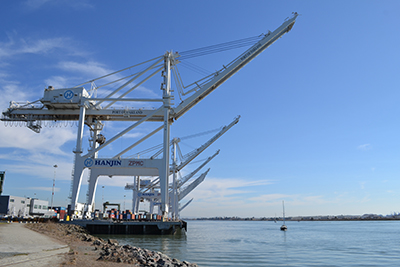Cranes going higher at Port of Oakland’s largest marine terminal
Up to six will be raised 27 feet; better for loading/unloading megaships

Infrastructure investments a the Port of Oakland keep being made, as the ocean cargo gateway continues to post record numbers of container throughput.
Up to six 366-foot-tall cranes will soon be raised 27-feet higher, the port announced today.
According to spokesmen, the $14 million-to-$21 million project will begin this spring at its largest marine terminal. The objective: make it easier to load and unload megaships with containers stacked high above deck.
“We’re already working the largest ships to call in North America,” said Port of Oakland Maritime Director John Driscoll. “By raising the height of ship-to-shore cranes, we make certain that we’re ready as more megaships head our way.”
The governing Board of Port Commissioners approved the crane plan at a meeting last night. It calls for installing longer legs on four-to-six cranes at Oakland International Container Terminal. The terminal handles 70 percent of Oakland’s cargo. Last winter it received the 1,300-foot long Benjamin Franklin, the largest container ship ever to visit the U.S.
The port's communication director, Mike Zampa, told LM that taller cranes give carriers more flexibility in how they stow cargo.
"That should provide opportunities for shippers. Taller cranes also ensure that we can work large vessels efficiently," he said. "That’s important because bigger ships mean more cargo moves on-and-off the vessel. We’ve got to keep up with the volume to keep cargo flowing"
The Port of Oakland said it will pay to raise the cranes. It added that the terminal operator, SSA, will repay the Port over the life of its Oakland lease.
Simply stated, here’s how cranes are raised:
*A massive jack lifts the entire structure off the terminal deck.
*Portions of the original crane legs are cut away.
*New leg extensions are placed under the crane and fastened into place.
The terminal said it hopes to begin work on the cranes in April. Completion is scheduled for the second quarter of 2018, depending on how many cranes are raised. That number will also determine the total cost of the project.
The Port said it will take about nine weeks to raise each crane. Jacking equipment is already en route to Oakland, the Port said. Up to 40 tractor-trailers will be used to transport the equipment. Steel leg extensions are being fabricated in China where the cranes were manufactured.
“We need bigger cranes to work the larger and more heavily laden ships calling Oakland,” said SSA President Ed DeNike. "It’s part of SSA’s long-term commitment to Oakland.”

Article Topics
News & Resources
Latest in Materials Handling
The (Not So) Secret Weapons: How Key Cabinets and Asset Management Lockers Are Changing Supply Chain Operations MODEX C-Suite Interview with Harold Vanasse: The perfect blend of automation and sustainability Consultant and industry leader John M. Hill passes on at age 86 Registration open for Pack Expo International 2024 Walmart chooses Swisslog AS/RS and software for third milk processing facility NetLogistik partners with Vuzix subsidiary Moviynt to offer mobility solutions for warehouses Materials Handling Robotics: The new world of heterogeneous robotic integration More Materials HandlingAbout the Author
Subscribe to Materials Handling Magazine

Find out what the world's most innovative companies are doing to improve productivity in their plants and distribution centers.
Start your FREE subscription today.
April 2024 Modern Materials Handling

Latest Resources










